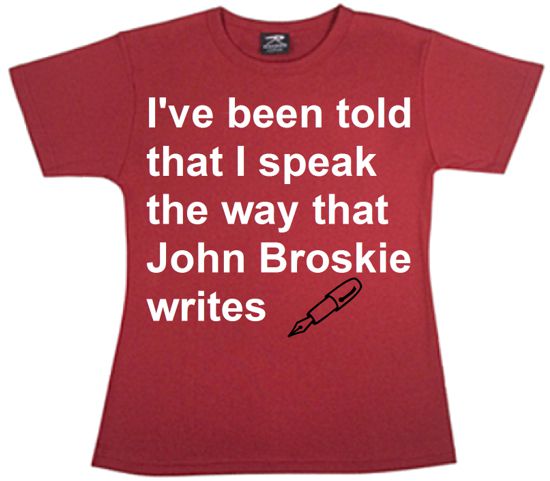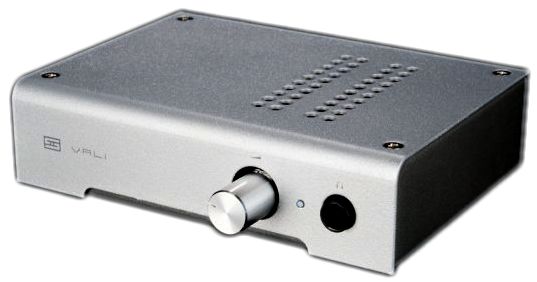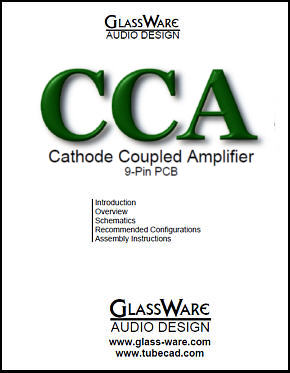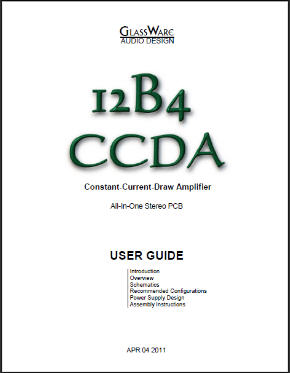| John Broskie's Guide to Tube Circuit Analysis & Design |
16 October 2013
RMAF 2013
Of course, 95% of the attendees do not know who I am, but the 5%, who do, tend do so in a big way, which is flattering, but also a wee bit disconcerting. Say, for example, that I am in an elevator and one of my readers recognizes me and throws me a compliment. Sounds good, but the other folks riding with us do not know who I am, but want to know who I am, so they start mumbling to each other, "Who is this guy?" Of course, if they had been told, they would have only been disappointed. No doubt, they would have been much more impressed had I been, for example, the first audio dealer in North Dakota to sell Linn turntables, a feat that they could understand and appreciate, truly something worthy of respect if not veneration, as they all could have done the same.
Early on my first day, I got to meet one of my favorite audio reviewers, which was and yet wasn't a great way to start the show off for me. With an almost war-wearied attitude, drained and almost crestfallen, he proclaimed that the year is 2013, not 1978; that—in spite of all the $3,000 power cords and $50,000 turntables and $70,000 speakers—Audio was, if not dead, certainly dying; that as we old audiophiles come to die, so, too, will our hobby, for there are no new young audiophiles in replacement; that whatever green-shoots counterexamples we might offer, such as the ever increasing sales of LPs, are so paltry and insignificant that they simply do not register in anything other than our imaginations; that the triumph of modern education has brought into being the lamest, most self-centered, most mis-educated people in history; that the equally big triumph of a socialism-lite wedded to self-indulgence and purposeless consumerism, a toxic mix indeed, has destroyed the very artistic, ethical, and societal underpinnings necessary for Audio to recover and thrive once again; and that all the illegal downloads of music have crippled the recorded-music industry beyond its ability to recuperate. Thus, audio gear and recorded music—if not all of us—are doomed.
His was an often-repeated speech, I could tell, which might explain why he delivered it in such an oddly fatigued fashion. An interesting perspective and it matches mine own in many particulars. Yet, perhaps because I am a cheerful pessimist, his prognoses sounded far too gloomy for my liking. Thus, much like Diogenes carrying a lamp in daylight in search of an honest man, I yearned to find counter evidence.
Because it was Friday morning, the retired male attendees overwhelmingly showed up, lending the assembly an old-folks-home quality. Not that I have anything against the wizened and hoary, being one myself, but they do cast a pall that is not so much Palladian as pallbearer-ready. Repeatedly, I heard, "Wait a second, will you? I have to take my medications" and "Not so fast, my damn hip is killing me." And the many canes and a few oxygen canisters-on-wheels also lent a senescent aspect to the entire event. Adding to the somniferous and decrescent tone was the overwhelming number of introverts. Let's be frank, Audio is a solitary pursuit; there is only one listening chair and one sweet spot. Headphones wall off the external world. Each audiophile is an island unto himself. With the advent of powerful car stereos and the iPod, most of the public have—if they ever knew—forgotten that audiophiles exist. Thus, the great attraction of an audio festival, such as the RMAF, as we aural loners and introverts can at last convene and commiserate. But as an aggressive sort of introvert, an INTJ in the Myers-Briggs personality types, I have some difficulty relating to the more passive introverts, as the passive do not instigate, but respond—if at all—submissively. No, I certainly wasn't at a Colorado cowboy convention; the boisterous and virile and optimistic were not invited. Instead, Thomas Malthus's ghost haunted many of the conversations, with dour pronouncements of impending ecological doom. I had the pleasure of hearing over and over again how global warming would kill us all in two decades—so why worry about audio's impending demise? Well, I am sure many who uttered such twaddle will in all likelihood be dead in in two decades, but the cause of death is not likely to be hyperthermia. So far, the famed reviewer seemed to be winning, as things did look bleak. On Saturday, I was happy to see the non-retired and non-male attendees show up, well at least there were a few. Children under 12-years of age were not charged an entry fee, yet there were so few. Go to a motorcycle or gun show and you will see children, lots of them. (Really, John, don't you understand that those parents should be charged with child abuse and put in jail or forced therapy! What could be more dangerous than motorcycles and guns? Surely, the greatest danger is excessively fearing the dangerous.) As a father and his ten-year old son exited a room, I overheard the boy say to his father, "I don't know, Dad, but do you still think that you make the best speakers?"
The Equipment I walked by one room and looked in and saw a guy with a head scarf and speakers pressed against the sidewalls. My gut reaction was that if he doesn't know enough to move the speakers away from the side walls, he will not know enough to build a good speaker. I was majorly wrong. The Audio Physic speakers sounded great and imaged extremely well and delivered taut bass—in spite of being next to the wall. The engaging and knowledgeable German rep told me all about how the speakers were designed and built. Very impressive, with things like porous ceramic internal walls and no sound absorbent material and drivers matched within 0.1dB to each other. Unfortunately, the speakers cost $27k, if I remember correctly.
Best Bargain
First let me say that I love everything about Schiit—their products, their prices, their sonics, everything but their name. "Aurous" would far more suitable. But Jason Stoddard and Mike Moffat are far too ironic to ever adopt such a name. A pity really, as many will overlook Schiit's amazingly fine and amazingly sanely-priced products. Well, it's their loss. In the Can Jam room of the RMAF, where headphones and headphone amplifiers are found, Schiit displayed at their booth a new hybrid headphone amplifier that used a pencil tube as its input stage and a solid-state buffer output stage. Apparently, this little wonder is so new that it hasn't shown up on their web page yet. It looks much like their Magni headphone amplifier and it sounds fabulous, with a jaunty, buoyant, and lively sound. Even if you already own a $2,000 headphone amplifier, this little gem is worth buying. Place it on your computer desk or next to your bed and live a happier life.
I Have Got the Blues
Why I Love the RMAF John Curl roamed the hallways, but I never ran into him, alas. Or, perhaps, I did, as we have never been introduced, another alas. Fortunately, I met and got to hang out with David Fletcher (cofounder of Sumiko, SOTA, and Pacific Microsonics). Mr. Fletcher is 77 and a hoot. He has a million great stories to tell and he does tell them; just try to stop him ;) I have only met one billionaire in my life and meeting David was a similar sort of experience, as I strove to shut up and to listen, for both men had invaluable things to say. I vividly remember that the rich man had only two rules for business success: 1) Never do anything illegal, ever. 2) Any business plan that assumes that other people are stupid, or will do stupid things, will fail, as people will always let you down by doing something smart. David Fletcher is as rich in audio knowledge—theory, practice, and imagination—as the billionaire was in money. I wish that either David lived in Colorado or I lived in Nevada.
RMAF Conclusions Well, after all my adventures at the 2013's RMAF, after my desperate search for some evidence that Audio—the art, practice, and science of designing home-audio electronics—did not await its priest and Last Rites, I was reminded of what H. L. Mencken had written about another foretold demise. From an article Mencken wrote in the Baltimore Evening Sun, in 1935, titled "Capitalism," we read the following:
Substitute the word "audio" for "capitalism" and similar conclusion follows: Audio will change, with some portions strengthened, while others weaken. If you look at only the traditional consumption side of Audio, the sale of receivers and CD players, you can easily prognosticate the worst. But if you solder and build and create, then things don't look so bleak after all. I remember being told many times, over many decades, that tubes were dead. Well, if they are, then someone forgot to notify me. The British philosopher and mathematician Bertrand Russell once wrote:
Next Time
//JRB |
I know that some readers wish to avoid Patreon, so here is a PayPal button instead. Thanks.
John Broskie
E-mail from GlassWare Customers
High-quality, double-sided, extra thick, 2-oz traces, plated-through holes, dual sets of resistor pads and pads for two coupling capacitors. Stereo and mono, octal and 9-pin printed circuit boards available.  Aikido PCBs for as little as $24 http://glass-ware.stores.yahoo.net/
Support the Tube CAD Journal & get an extremely powerful push-pull tube-amplifier simulator for TCJ Push-Pull Calculator
TCJ PPC Version 2 Improvements Rebuilt simulation engine *User definable
Download or CD ROM For more information, please visit our Web site : To purchase, please visit our Yahoo Store:
And
High-quality, double-sided, extra thick, 2-oz traces, plated-through holes, dual sets of resistor pads and pads for two coupling capacitors. Stereo and mono, octal and 9-pin printed circuit boards available.
Designed by John Broskie & Made in USA Aikido PCBs for as little as $24 http://glass-ware.stores.yahoo.net/
The Tube CAD Journal's first companion program, TCJ Filter Design lets you design a filter or crossover (passive, OpAmp or tube) without having to check out thick textbooks from the library and without having to breakout the scientific calculator. This program's goal is to provide a quick and easy display not only of the frequency response, but also of the resistor and capacitor values for a passive and active filters and crossovers. TCJ Filter Design is easy to use, but not lightweight, holding over 60 different filter topologies and up to four filter alignments: While the program's main concern is active filters, solid-state and tube, it also does passive filters. In fact, it can be used to calculate passive crossovers for use with speakers by entering 8 ohms as the terminating resistance. Click on the image below to see the full screen capture. Tube crossovers are a major part of this program; both buffered and un-buffered tube based filters along with mono-polar and bipolar power supply topologies are covered. Available on a CD-ROM and a downloadable version (4 Megabytes). |
||
| www.tubecad.com Copyright © 1999-2013 GlassWare All Rights Reserved |



































